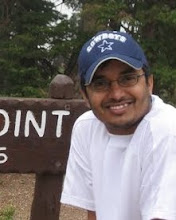Another day went past so quickly.
Now things are moving much faster than I experienced in the first two days.
I was getting familiar with many people in the workshop and we were starting to enjoy the company of each other. Also today's talk was fairly okay. Out of the four lectures that was presented today, one was very good, one was good, one was poor and I skipped the last one (I skipped part two of the lecture on locomotion by Cohen).
The lecture that was very interesting and useful covering many details of the visual processing was given by Prof. David Heeger from New York University.

He tried to cover many insights on the visual trajectory especially from the Cortex point of view. Since I have read the Eye. Brain and Vision by Hubel, I found the lecture easy to follow and understand. He pointed out some good insights into the higher levels of the brain from MT onwards. I would give him 4/5 for his excellent presentation, interesting outlook and for his nice Q&A sessions.
The other talk in the morning was given Lick Lyon, a student of Carver Mead from Caltech (In fact majority of the speakers were direct descendant's of Mead).

He went into the details of his analytical modeling of Human Cochlea. His talk was interesting and had many historical perspective and touched mainly on quantitative evaluation of Human Cochlea from filter bank perspective.
The remaining two talks was given by Avis Cohen and Tara Hamilton. Tara Hamilton (pics below) had some interesting ideas but overall I did not like the talk because of lack of focus or depth or clarity in the presentation.

Later in the evening a avalanche of topics related to Neuromorphic Engineering was presented. I will mostly focus on the spike based processing scheme and its related topics. I was also thinking of giving a small talk on GPGPU computing and using GPGPU for simulating neuromorphic principles.
One interesting visitor for this workshop was a small girl ( I need to find her name).

In the night we had a small get together in our house and one of my room mates (Max) prepared the food for the night. It is good that he initiated the idea as the home became more lively and we got to know each other in the house well. Thanks to Max for his initiative and his effort.

(Above picture from the windows of our lecture room)









 He tried to cover many insights on the visual trajectory especially from the Cortex point of view. Since I have read the Eye. Brain and Vision by Hubel, I found the lecture easy to follow and understand. He pointed out some good insights into the higher levels of the brain from MT onwards. I would give him 4/5 for his excellent presentation, interesting outlook and for his nice Q&A sessions.
He tried to cover many insights on the visual trajectory especially from the Cortex point of view. Since I have read the Eye. Brain and Vision by Hubel, I found the lecture easy to follow and understand. He pointed out some good insights into the higher levels of the brain from MT onwards. I would give him 4/5 for his excellent presentation, interesting outlook and for his nice Q&A sessions. He went into the details of his analytical modeling of Human Cochlea. His talk was interesting and had many historical perspective and touched mainly on quantitative evaluation of Human Cochlea from filter bank perspective.
He went into the details of his analytical modeling of Human Cochlea. His talk was interesting and had many historical perspective and touched mainly on quantitative evaluation of Human Cochlea from filter bank perspective. Later in the evening a avalanche of topics related to Neuromorphic Engineering was presented. I will mostly focus on the spike based processing scheme and its related topics. I was also thinking of giving a small talk on GPGPU computing and using GPGPU for simulating neuromorphic principles.
Later in the evening a avalanche of topics related to Neuromorphic Engineering was presented. I will mostly focus on the spike based processing scheme and its related topics. I was also thinking of giving a small talk on GPGPU computing and using GPGPU for simulating neuromorphic principles. In the night we had a small get together in our house and one of my room mates (Max) prepared the food for the night. It is good that he initiated the idea as the home became more lively and we got to know each other in the house well. Thanks to Max for his initiative and his effort.
In the night we had a small get together in our house and one of my room mates (Max) prepared the food for the night. It is good that he initiated the idea as the home became more lively and we got to know each other in the house well. Thanks to Max for his initiative and his effort. (Above picture from the windows of our lecture room)
(Above picture from the windows of our lecture room)






